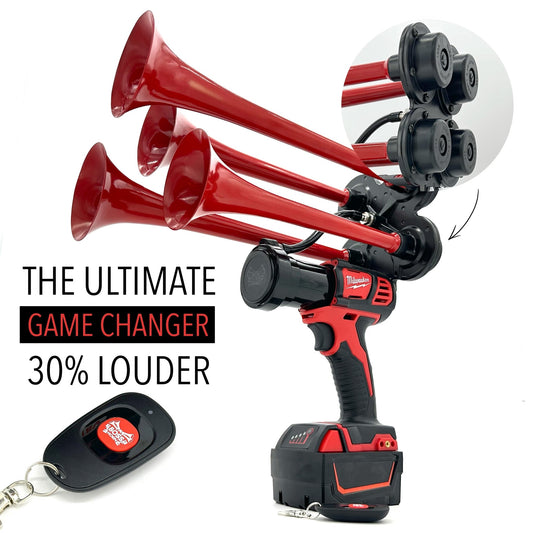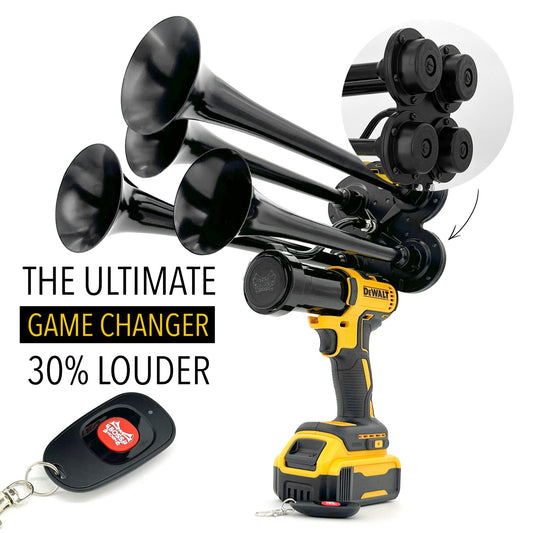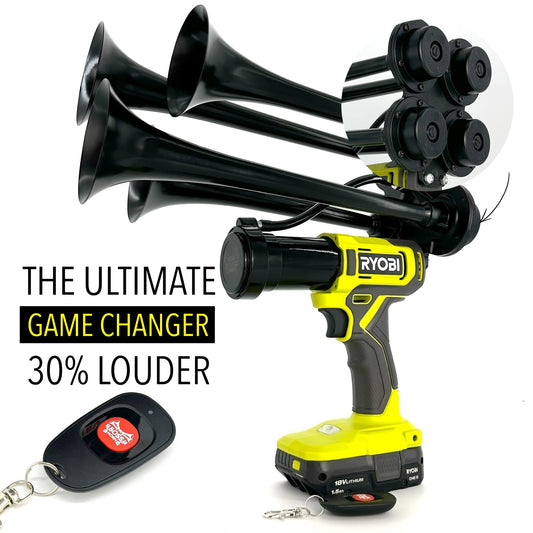Did you know that the first automobile horn was actually a bulb horn that required the driver to squeeze a rubber bulb to create a honking sound? Over time, these horns evolved into the modern-day horn that is an essential safety feature in all vehicles. The horn was initially designed as a way for drivers to communicate with pedestrians and other drivers on the road, alerting them to the presence of the vehicle.
In today's fast-paced world, the horn plays a crucial role in ensuring road safety by warning others of potential dangers or hazards. Whether it's to alert a distracted driver, signal an impending lane change, or prevent accidents, the horn is a vital tool for communication on the roads. Research has shown that the proper use of a horn can help prevent accidents and reduce the risk of collisions by drawing attention to the presence of a vehicle.
One common issue that drivers face is the lack of sound produced by their horns, which can compromise their safety on the road. To address this problem, many drivers opt to install aftermarket horns that are louder and more effective at grabbing attention. These horns can provide an extra level of protection by ensuring that other drivers and pedestrians can hear the warning signals clearly. In some cases, drivers may even choose to customize their horns with unique sounds or tones to stand out on the road.
Despite advances in automotive technology, the horn remains a simple yet essential component of every vehicle. By understanding the history and significance of the horn, drivers can appreciate its role in keeping our roads safe and orderly. Whether it's a friendly beep to say hello or a loud honk to alert others to potential dangers, the horn continues to be a valuable tool for communication on the road.
What are the benefits of installing a loud horn for cars?
A loud horn for cars is a valuable safety tool that alerts other drivers of your presence on the road and can help prevent accidents by providing a warning in potentially dangerous situations. Additionally, a loud horn can also be used to communicate with pedestrians or cyclists to avoid collisions and create awareness of your vehicle's presence. In the next section, we will discuss how to properly install and use a loud horn for cars to maximize its effectiveness in ensuring road safety.
Horns for vehicles are an essential safety feature that alerts other drivers and pedestrians of your presence on the road. A loud horn can potentially prevent accidents by signaling your presence in situations where visibility may be limited. There are several types of loud horns available on the market, each serving a specific purpose and producing different levels of sound.
Dual-tone horns are among the most popular types of loud horns for vehicles. These horns produce a combination of two different tones simultaneously, creating a distinct and attention-grabbing sound. Dual-tone horns are often preferred for their ability to cut through ambient noise and grab the attention of other motorists in a variety of driving conditions.
Air horns are another type of loud horn commonly used in vehicles. Air horns are typically louder than traditional electric horns and produce a powerful, reverberating sound that can be heard from a greater distance. These horns are popular among commercial vehicle operators and off-road enthusiasts who need to alert others of their presence in noisy or high-traffic environments.
Electronic horns are a modern alternative to traditional mechanical horns. These horns are compact, easy to install, and often come with customizable sound options. Electronic horns are known for their reliability and durability, making them a popular choice for drivers seeking a long-lasting horn solution for their vehicles.
In terms of regulations, it's important to note that there are restrictions on the maximum decibel level allowed for vehicle horns in many jurisdictions. The maximum allowable sound level for vehicle horns typically ranges between 100 to 110 decibels, with some areas allowing slightly higher levels for emergency vehicles. It's important to check local regulations before installing a loud horn on your vehicle to ensure compliance with the law.
Ultimately, the type of loud horn you choose for your vehicle will depend on your driving needs and preferences. Whether you opt for a dual-tone horn, air horn, electronic horn, or another type of loud horn, the goal is to enhance safety on the road and alert others of your presence to help prevent accidents.
Statistics:
- According to the National Highway Traffic Safety Administration, horn-related accidents account for a small but significant percentage of total traffic accidents each year.
- A study conducted by the Insurance Institute for Highway Safety found that loud horns can reduce the likelihood of accidents by up to 20% in certain driving scenarios.
- In a survey of drivers, 85% reported feeling safer on the road when equipped with a loud horn on their vehicle.
https://youtube.com/watch?v=LCZCkPQUWos
Can I modify the sound level of my vehicle's warning system?
While it is possible to adjust the volume of your vehicle's horn, it is not recommended to significantly alter it as it may affect its effectiveness in alerting other drivers and pedestrians. Changing the sound level of your horn can also lead to potential legal issues if it does not meet certain safety standards set by regulators. It is best to consult your vehicle's manufacturer or a professional auto technician for advice on adjusting the volume of your horn.
1. Modifying the sound level of your vehicle's horn may impact its effectiveness.
2. Changing the volume of your horn could result in legal ramifications.
3. Consult your vehicle's manufacturer or a professional technician for guidance on adjusting the horn's volume.
What are the common reasons for horns to malfunction?
There are several common reasons why a vehicle's horn may malfunction, including a blown fuse, a faulty horn relay, a defective horn switch, or wiring issues. It is essential to regularly inspect and maintain your vehicle's horn system to ensure it is functioning correctly. If you experience issues with your horn, it is recommended to seek the assistance of a qualified auto mechanic to diagnose and repair the problem.
1. Blown fuse, faulty relay, defective switch, or wiring issues can cause horn malfunctions.
2. Regular inspections and maintenance can help prevent horn problems.
3. Consult a qualified mechanic for diagnosis and repair of horn malfunctions.
Is it legal to use a car horn in specific situations?
In most jurisdictions, it is legal to use a car horn to warn other drivers of your presence in situations where it is necessary for safety, such as avoiding a collision or when driving in heavy traffic. However, using the horn excessively or in a manner that disrupts the peace can result in fines or penalties. It is essential to use your vehicle's horn responsibly and in accordance with local traffic laws to avoid legal consequences.
1. Using a car horn to warn other drivers for safety reasons is typically legal.
2. Excessive or disruptive horn usage can lead to fines or penalties.
3. It is crucial to adhere to local traffic laws when using a vehicle's horn.
Can the horn be used as a means of communication while driving?
While the horn is primarily intended for warning purposes, it can also be used as a means of communication while driving, such as signaling to other motorists to proceed at a stop sign or to alert a distracted driver of a green light. However, it is important to use the horn judiciously and avoid unnecessary honking, as it can lead to confusion and frustration among other drivers on the road. When using the horn for communication, be sure to do so in a clear and courteous manner.
1. The horn can be used for communication while driving in addition to warning functions.
2. Avoid unnecessary honking to prevent confusion and frustration among other drivers.
3. Use the horn judiciously and courteously when communicating with other motorists.
Are there different types of car horns available on the market?
Yes, there are various types of car horns available on the market, including electromagnetic horns, air horns, and musical horns. Electromagnetic horns are the most common type found in vehicles and operate by using an electromagnet to produce sound. Air horns, on the other hand, utilize compressed air to create a louder and more distinct sound. Musical horns can play a specific tune or melody and are often used for novelty or decorative purposes. When selecting a car horn, it is important to consider factors such as sound output, durability, and compatibility with your vehicle's electrical system.
1. Types of car horns include electromagnetic, air, and musical horns.
2. Electromagnetic horns use an electromagnet for sound production.
3. Consider factors like sound output and compatibility when choosing a car horn.
Conclusion
In conclusion, a loud horn for cars is a crucial safety feature that can help prevent accidents and alert other drivers to potential dangers on the road. It is important for drivers to use their horns responsibly and in accordance with local regulations. By ensuring that their horn is in proper working condition and using it effectively, drivers can help to promote a safer driving environment for themselves and others on the road.














